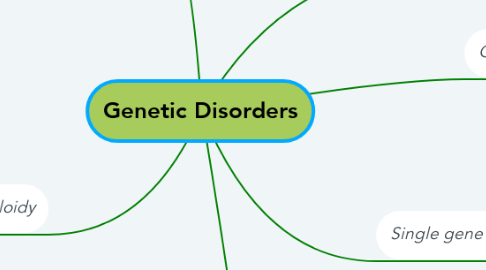Genetic Disorders
by Lydia Palaiologou

1. Genetic disorder
1.1. Genetic disorder is an inherited medical condition. Genetic disorders are usually related to chromosomes.
1.2. It is caused by a genetic abnormality (something that is not like it is supposed to be) in one's DNA structure.
2. Bibliography
2.1. Genetic Disorders website
3. Aneuploidy
3.1. Aneuploidy is when someone has too many of not enough chromosomes
3.2. There are 2 types or aneuploidy. Monosomy, where in a pair of chromosomes there is only one instead of two and trisomy, where there is an extra chromosome in a pair so there are three chromosome instead of two.
3.3. Aneuploidy happens when your eggs/sperm is created. The first cell includes a pair of each chromosome and then they multiply and divide equally to create more cells with chromosomes. Sometimes they do not divide equally and that is when a cell ends up with three or 1 chromosomes for a pair.
3.4. Examples: Trisomy 21 - Down Syndrome Monoploidy 47, XO - Turner Syndrome
4. Single gene disorders
4.1. Single gene disorders are caused by variations in ones DNA structure of a specific gene.
4.2. Some examples of single gene disorders are: Cystic Fibrosis (CF), Huntington Disease (HD), Maple Syrup Urine Disease (MSUD)
5. Chromosomal Rearrangement
5.1. A chromosomal rearrangement means that pieces of chromosomes are missing, have been duplicated (there are extra copies), or moved around.
5.2. A chromosomal rearrangement is usually diagnosed through genetic testing. A DNA sample is usually taken from ones blood or from a cheek swab.
6. Can you live with a genetic dissorder?
6.1. Yes and no. It depends. Some disorders, like the Down Syndrome, are compatible with life but others are not. Some do not effect the body physically or mentally at all. It really comes down to the gene, chromosome or chromosome pair that has been effected in any way.


